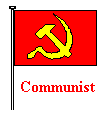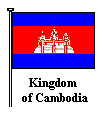The earliest civilization on the mainland of Southeast Asia, with the earliest dated inscription in Cambodian from 611 AD, but some earlier Sanskrit inscriptions, Cambodia grew into perhaps the most brilliant, leaving the most substantial and impressive architectual remains of any.
The Cambodian or Khmer language is of the Mon-Khmer group, along with Vietnamese, Mon and Wa in Burma, and Khmu in northern Laos. They are related to the Munda languages in eastern India -- Santali, Mundari, and Khasi. Unlike the Thai-Lao languaes, and Vietnamese, which may have gotten the feature from them (like Chinese), Cambodian does not use tones. The appearance, then, is that this was the indigenous language group of Southeast Asia, which was broken apart by incursions of Sino-Tibetan (Burmese) and Thai-Lao. The movement of the Burmese must have been very early, but the Thai-Lao languages did not come in until the 13th century. The earliest days of Cambodia, then, see the Kingdom dominating what later would be, not just Cambodia, but also Thailand and Laos.
With little early contact with China, Cambodia developed as a purely sub-Indian civilization, with contact by way of the already existing Indian culture of Indonesia. Indeed, the only Southeast Asian monumental architecture to match Cambodia is the 9th century Buddhist temple of Borobudur on Java.
 Cambodian
writing is based on the Sanskrit alphabet and even preserves Sanskrit
alphabetical order. Cambodian has far fewer consonants than Sanskrit,
but many more vowels. The redundant consonants are then used to
indicate vowel distinctions.
Cambodian
writing is based on the Sanskrit alphabet and even preserves Sanskrit
alphabetical order. Cambodian has far fewer consonants than Sanskrit,
but many more vowels. The redundant consonants are then used to
indicate vowel distinctions.
 The Khmer capital at Ângkôr is the site of the temple- mausolea of the
Cambodian Kings. The most famous and impressive of these is Ângkôr Wat,
the tomb of King Suryavarman II. This has become a symbol of Cambodia
itself, and of a greatness that, all too tragically, stands in stark
contrast to the horrors of more recent Cambodian history.
The Khmer capital at Ângkôr is the site of the temple- mausolea of the
Cambodian Kings. The most famous and impressive of these is Ângkôr Wat,
the tomb of King Suryavarman II. This has become a symbol of Cambodia
itself, and of a greatness that, all too tragically, stands in stark
contrast to the horrors of more recent Cambodian history.
This list was largely derived from Bruce R. Gordon's Regnal Chronologies, with some details added from An Encyclopedia of World History (William L. Langer, Houghton Mifflin, 1952). The Maps are based on the Oxford Atlas of World History (Patrick K. O'Brien, General Editor, 1999, pp.64-65). Good lingustic information is in The Atlas of Languages (Facts On File, 1996, pp.62-64). Other language information about Cambodian is from Cambodian System of Writing and Beginning Reader, by Franklin E. Huffman [Yale University Press, 1970]. Gordon's listing of Norodom Sihanouk as "Norodom Sihanouk II" is a little puzzling, since there is no earlier "Norodom Sihanouk" in the list. There is an earlier "Norodom," which would make him "Norodom I" and our contemporary leader "Norodom II Sihanouk," but this would make Sihanouk's father, Norodom Suramarit, into "Norodom III Suramarit." That is how I have given it, in the absence of better information.
 Like Laos, Cambodia came under Thai control and then passed, somewhat
earlier than Laos, into the French Imperium. Again like Laos, Cambodia,
regained independence in 1954 as a neutralist state.
Like Laos, Cambodia came under Thai control and then passed, somewhat
earlier than Laos, into the French Imperium. Again like Laos, Cambodia,
regained independence in 1954 as a neutralist state.
Cambodian neutrality, like Laotian, was ignored by the Vietnamese Communists, who used Cambodian territory for the terminus of the "Ho Chi Minh Trail" through Laos, and then as a staging area and refuge for operations in South Vietnam. There wasn't much that Prince Norodom Sihanouk could do about this. Tacitly tolerating it, by pretending that it wasn't going on, seemed the best way not to antagonize the Vietnamese, while hoping that the Americans would avoid expanding their operations. However, this was not to be.
President Nixon had already been secretly bombing in Cambodia when he publicly launched an invasion in 1970. This led to a coup in Cambodia. Prince Sihanouk was overthrown and an overtly anti-Communist government came to power. As Sihanouk had feared, the Vietnamese then gave the green light to the Cambodian Communists, the Khmer Rouge, to attempt their own take-over. But Sihanouk, ironically, found himself on the same side.
When South Vietnam fell in 1975, Cambodia was not far behind, but what the Khmer Rouge had in mind for their country, newly renamed Democratic Kampuchea, made
 earlier
Communist revolutions look like the most fainthearted reformism. The
entire urban population of the country was chased out of the cities.
Anyone displaying any evidence of office, wealth, or education, even
people simply wearing glasses, were summarily executed. The project was
an inflated Maoist fantasy of returning the whole nation to communal
peasant life, whether they wanted to do that or not. Anyone showing the
slightest resistance or slightest independence of thought, even
expressing affection for family members, might be tortured or killed.
earlier
Communist revolutions look like the most fainthearted reformism. The
entire urban population of the country was chased out of the cities.
Anyone displaying any evidence of office, wealth, or education, even
people simply wearing glasses, were summarily executed. The project was
an inflated Maoist fantasy of returning the whole nation to communal
peasant life, whether they wanted to do that or not. Anyone showing the
slightest resistance or slightest independence of thought, even
expressing affection for family members, might be tortured or killed.
At the time, not much was known about this. The international press had been expelled from the country, and whatever the Khmer Rouge were doing passed out of public knowledge. Then the rumors started, born by horrified refugees. The reponse to this in the West was instructive. The leftist press blamed all the bad rumors on CIA misinformation and featured sober discussions of how the Cambodians conceived Communism differently from the Vietnamese. Fraternal solidarity and all that, just a few different means to the same ends.
If the Khmer Rouge, led by the "French educated" Pol Pot, with Prince Sihanouk for a year as a figurehead, had then minded their own business, they probably could have done whatever they wanted in their country for the indefinite future, and let the world think whatever it wanted. But they had a grudge against Vietnam, probably something only understandable at the rarified level of political paranoia and insanity that they practiced. They kept attacking the Vietnamese, and eventually the Vietnamese, with one of the largest armies in the world, and not much to do since the war ended, attacked back, invading Cambodia and overthrowing the government in 1979. To justify their actions and gain internationl approval all they needed to do was open the gates of Cambodia to foreign inspection. The piles of bones and skulls told the tale, as well as the careful documentation by the Khmer Rouge of much of it, including photos of those to be executed.
The Khmer Rouge, as it happens, had murdered between a third and a half of the population of the entire country. It may be that nothing quite like this has ever happened before in history, where the native government of a country more than decimates its own people. All to build a perfect society, on the basis of "scientific" principles from Marx, Lenin, Stalin, and Mao.
Now there was no diguising the truth. One story among many of horror and flight and refuge was told in the movie, The Killing Fields [1984]. But the leftists who had previously expressed their somber esteem for Democratic Kampuchea now had a new approach. It was all our fault. If Nixon had not drawn Cambodia into the war, then none of this would ever have happened. How it is that Nixon wronged peace and decency when the Vietnamese Communist had not done so, by passing through and using Cambodia in the first place, was a question unasked; for obviously, whatever the Communists did was in a good cause, and it was incumbent on the capitalists to respect the neutrality of a country that had became a de facto belligerent in the Vietnamese Revolution. It was also always a good question why Communists were always compelled to imprison and murder their own people whenever we were unfriendly to them, or why they would have acted differently if no one had been paying any attention. I've never heard what Hitler did excused just because so many were opposed to him, but, by the reasoning we are given, the case could be made that Hitler was driven to genocide just because the West was making war against him. But the idea that Communists all would have been good liberals and democrats if only we hadn't been mean to them is now well established, not just in the blame-American-first crowd, but even in the common consensus of academics and intellectuals.
The Khmer Rouge, chased into the countryside, fought on; and the pro-Vietnamese official government of Cambodia found itself without much international recognition. The fall of Communism in Eastern Europe helped bring about a settlement.
 Prince
Sihanouk, whom no one ever thought of as pro-Vietnamese, returned from
exile to supervise a new government and then be installed as King, which
office he had abdicated in 1955. The Khmer Rouge were given a role,
but they ended up falling out among themselves, even claiming to have
tried Pol Pot, before his death, for all of the crimes of their regime.
What may really have happened is that, with Sihanouk officially back in
power, the Communists lost their lifeline of support from China,
without which no one else would give them the time of day. So they
begin to whither on the vine. One then hopes that Cambodia will finally
return to some kind of normalcy, though meanwhile, amid all the
fighting and anarchy, the priceless heritage of Ângkôr Wat and other
sites has been damaged by looters. Back in the 60's, Prince Sihanouk
had said that when elephants fight, the mice scatter. Cambodia, sadly,
was a mouse that didn't get away and was crushed by events.
Prince
Sihanouk, whom no one ever thought of as pro-Vietnamese, returned from
exile to supervise a new government and then be installed as King, which
office he had abdicated in 1955. The Khmer Rouge were given a role,
but they ended up falling out among themselves, even claiming to have
tried Pol Pot, before his death, for all of the crimes of their regime.
What may really have happened is that, with Sihanouk officially back in
power, the Communists lost their lifeline of support from China,
without which no one else would give them the time of day. So they
begin to whither on the vine. One then hopes that Cambodia will finally
return to some kind of normalcy, though meanwhile, amid all the
fighting and anarchy, the priceless heritage of Ângkôr Wat and other
sites has been damaged by looters. Back in the 60's, Prince Sihanouk
had said that when elephants fight, the mice scatter. Cambodia, sadly,
was a mouse that didn't get away and was crushed by events.
















Tiada ulasan:
Catat Ulasan